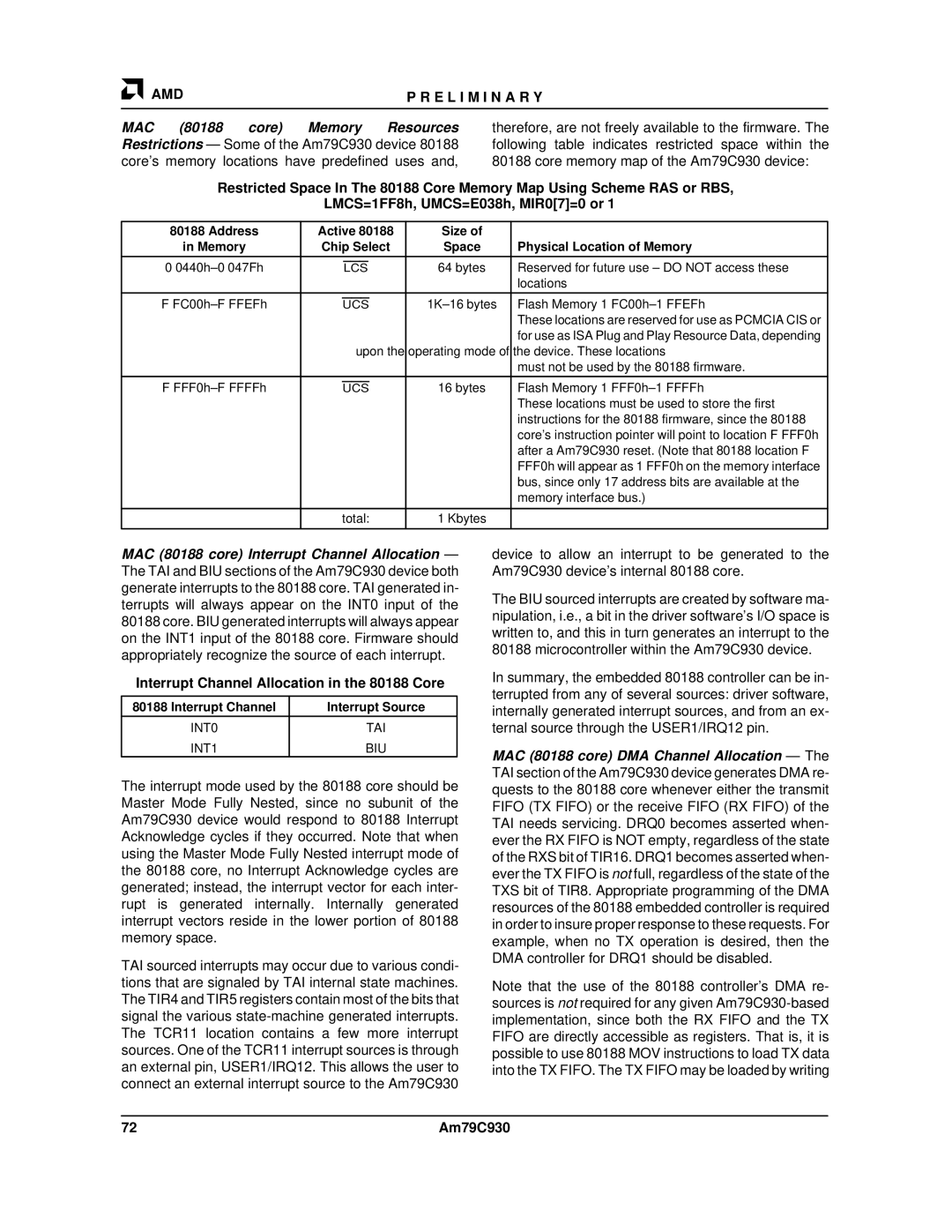
AMD | P R E L I M I N A R Y |
|
|
MAC (80188 core) Memory Resources Restrictions — Some of the Am79C930 device 80188 core's memory locations have predefined uses and,
therefore, are not freely available to the firmware. The following table indicates restricted space within the
80188 core memory map of the Am79C930 device:
Restricted Space In The 80188 Core Memory Map Using Scheme RAS or RBS,
LMCS=1FF8h, UMCS=E038h, MIR0[7]=0 or 1
80188 Address | Active 80188 | Size of |
|
in Memory | Chip Select | Space | Physical Location of Memory |
|
|
|
|
0 | LCS | 64 bytes | Reserved for future use – DO NOT access these |
|
|
| locations |
|
|
|
|
F | UCS | Flash Memory 1 | |
|
|
| These locations are reserved for use as PCMCIA CIS or |
|
|
| for use as ISA Plug and Play Resource Data, depending |
| upon the | operating mode of | the device. These locations |
|
|
| must not be used by the 80188 firmware. |
|
|
|
|
F | UCS | 16 bytes | Flash Memory 1 |
|
|
| These locations must be used to store the first |
|
|
| instructions for the 80188 firmware, since the 80188 |
|
|
| core's instruction pointer will point to location F FFF0h |
|
|
| after a Am79C930 reset. (Note that 80188 location F |
|
|
| FFF0h will appear as 1 FFF0h on the memory interface |
|
|
| bus, since only 17 address bits are available at the |
|
|
| memory interface bus.) |
|
|
|
|
| total: | 1 Kbytes |
|
|
|
|
|
MAC (80188 core) Interrupt Channel Allocation — The TAI and BIU sections of the Am79C930 device both generate interrupts to the 80188 core. TAI generated in- terrupts will always appear on the INT0 input of the 80188 core. BIU generated interrupts will always appear on the INT1 input of the 80188 core. Firmware should appropriately recognize the source of each interrupt.
Interrupt Channel Allocation in the 80188 Core
80188 Interrupt Channel | Interrupt Source |
INT0 | TAI |
INT1 | BIU |
The interrupt mode used by the 80188 core should be Master Mode Fully Nested, since no subunit of the Am79C930 device would respond to 80188 Interrupt Acknowledge cycles if they occurred. Note that when using the Master Mode Fully Nested interrupt mode of the 80188 core, no Interrupt Acknowledge cycles are generated; instead, the interrupt vector for each inter- rupt is generated internally. Internally generated interrupt vectors reside in the lower portion of 80188 memory space.
TAI sourced interrupts may occur due to various condi- tions that are signaled by TAI internal state machines. The TIR4 and TIR5 registers contain most of the bits that signal the various
device to allow an interrupt to be generated to the Am79C930 device's internal 80188 core.
The BIU sourced interrupts are created by software ma- nipulation, i.e., a bit in the driver software's I/O space is written to, and this in turn generates an interrupt to the 80188 microcontroller within the Am79C930 device.
In summary, the embedded 80188 controller can be in- terrupted from any of several sources: driver software, internally generated interrupt sources, and from an ex- ternal source through the USER1/IRQ12 pin.
MAC (80188 core) DMA Channel Allocation — The TAI section of the Am79C930 device generates DMA re- quests to the 80188 core whenever either the transmit FIFO (TX FIFO) or the receive FIFO (RX FIFO) of the TAI needs servicing. DRQ0 becomes asserted when- ever the RX FIFO is NOT empty, regardless of the state of the RXS bit of TIR16. DRQ1 becomes asserted when- ever the TX FIFO is not full, regardless of the state of the TXS bit of TIR8. Appropriate programming of the DMA resources of the 80188 embedded controller is required in order to insure proper response to these requests. For example, when no TX operation is desired, then the DMA controller for DRQ1 should be disabled.
Note that the use of the 80188 controller's DMA re- sources is not required for any given
72 | Am79C930 |
